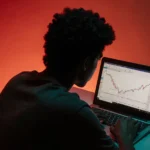
Day trading ETFs is like surfing market momentum with a flexible, powerful board. You get broad exposure to entire sectors, indexes, or asset classes in a single trade — without diving deep into individual stocks. With their liquidity, low costs, and transparency, ETFs are perfect tools for traders who want speed, structure, and versatility. This article covers the mechanics of ETFs, highlights top picks for intraday action, outlines smart day trading strategies, and shows how to manage risks like a pro.
What Is an ETF and How Does It Work?
Definition and Structure of ETFs
An exchange-traded fund is a collection of assets- stocks, bonds or commodities- that is bought and sold on a stock exchange similar to a stock. Each share of a unit of an ETF represents an indivisible proportionate interest in the underlying assets. ETFs are meant to track either an index, sector, or theme and thus, they are straightforward to comprehend and easy to trade.
ETF Pricing and Liquidity
ETFs differ from mutual funds in that they can be bought and sold throughout the day at the prevailing market price. Very often, they have good liquidity- especially the well-known ETFs for major indexes- which means that tighter spreads and smoother entries and exits occur. Day traders love such flexibility combined with quick execution.
ETF vs Mutual Fund: Key Differences
On the contrary, while mutual funds are priced once a day, they can be managed either actively or passively; ETFs, conversely, are intraday instruments designed for speed. Low expense ratio, no load, and live prices make ETFs a much more natural choice for tactical short-term traders than mutual funds ever will.
Why Trade ETFs for Intraday Strategies?
High Liquidity and Tight Spreads
Liquidity is king in day trading, and ETFs like SPY and QQQ trade millions of shares daily. High volume ensures minimal slippage and tighter bid/ask spreads, which makes a difference when executing multiple trades per session.
Sector and Index Exposure
ETFs offer instant diversification. Instead of betting on one bank stock, you can trade an entire financial sector via XLF. Want to ride tech volatility? Go with QQQ. This broad exposure reduces single-stock risk while capturing directional moves.
Cost Efficiency and Low Barriers
With no minimum investment requirements and expense ratios often below 0.10%, ETFs are highly cost-effective. Commission-free trading on many platforms sweetens the deal, making them attractive even for small accounts.
Leveraged and Inverse ETF Options
Looking to amplify your returns — or take a contrarian view? Leveraged ETFs (like TQQQ or SPXL) magnify daily gains (or losses), while inverse ETFs (like SQQQ or SPXS) profit when the market drops. These tools require caution but open doors for advanced strategies.
Top Market ETFs for Day Trading
SPDR S&P 500 ETF Trust (SPY)
The most actively traded ETF in the world, SPY tracks the S&P 500 and offers unparalleled liquidity. It’s a go-to for both beginners and veterans.
Invesco QQQ Trust (QQQ)
Tracking the Nasdaq‑100, QQQ is tech-heavy and volatile — perfect for momentum traders who like fast action.
iShares Russell 2000 ETF (IWM)
IWM represents small-cap stocks and often moves more sharply than large-cap indexes, making it ideal for traders seeking bigger intraday swings.
Direxion Daily Financial Bull 3X Shares (FAS)
FAS offers triple-leveraged exposure to the financial sector. It’s highly reactive to banking news, interest rates, and earnings.
ProShares Ultra VIX Short-Term Futures ETF (UVXY)
UVXY is a volatility ETF — not for the faint-hearted. It tends to spike during market fear and crashes. Best used with tight risk controls.
SPDR Gold Shares (GLD)
GLD offers exposure to gold prices, acting as a safe-haven play or inflation hedge. It’s a useful alternative when equities stall.
Effective Day Trading Strategies Using ETFs
Breakout Trading
This strategy targets price levels where an ETF bursts above resistance or below support on strong volume. Look for consolidation patterns before the breakout to boost odds of success.
Moving Average Crossovers
Using 9-day and 21-day EMAs, traders watch for bullish or bearish crossovers to initiate positions. ETFs trending with the broader market often react reliably to these signals.
Momentum and Volume Surges
ETFs often move sharply on increased volume. Scan for relative volume spikes and confirmation from momentum indicators like RSI or MACD to identify potential intraday plays.
Gap and Go Strategy
ETFs that gap up or down at the open due to news or macro data can continue in that direction. Traders ride the initial momentum for fast intraday gains — ideal with SPY, QQQ, or IWM.
Reversal and Mean Reversion Trades
Overextended ETFs can pull back to the mean. Look for high RSI (overbought) or low RSI (oversold) plus volume divergence to catch reversals. Works well near previous support/resistance.
Risk Management Techniques for ETF Day Trading
Setting Stop Loss and Take Profit
Every trade should have predefined exits. Use technical levels like previous highs/lows or ATR (Average True Range) to set realistic stop-loss and profit targets.
Using Volatility Indicators
VIX, Bollinger Bands, and average range indicators provide a perspective to help you decide if the ETF environment favors breakout or mean reversion techniques. The high-leverage ETFs are to be avoided when the prices just spike without notice.
Diversification Across ETF Types
Do not put your capital into very similar types of business. A mixture of SPY and GLD or UVXY will serve as a very good hedge for directional bias, especially on those volatile days.
Managing Leverage and Position Size
Keep your position sizes small when trading leveraged ETFs such as FAS or UVXY. These instruments can often swing up 10% within a single trading session, often magnifying gains or perhaps turning what were smaller losses into serious ones.
Day Trading Tools and Platforms for ETFs
Charting Software and Real-Time Data
Tools like TradingView, Thinkorswim, and MetaTrader provide customizable charts, indicators, and real-time feeds — crucial for fast decisions.
Mobile and Desktop Trading Applications
Applications like Webull, Interactive Brokers, and TD Ameritrade permit trading of ETFs while on the move with full platform functionality and rapid order executions. Many active traders also use a social trading app to follow experienced ETF traders, view leaderboards, and mirror proven intraday setups alongside their own strategies.
ETF Screeners and Scanners
Use screeners like Finviz, Benzinga, or your broker’s platform to find the ETFs which are in high volume, with high volatility or unusual price activity.
Broker Features for Active Traders
Look for platforms offering advanced order types, hotkey support, and margin access. Low fees and instant fills can significantly improve your trading edge.
FAQs About Day Trading ETFs
Can ETFs Trade Like Stocks All Day?
Yes, they do trade on exchanges just like individual securities between market opening and closing.
What Times Are Best to Trade ETFs?
Volume and volatility usually peak in the first hour after market opening from 9:30 to 10:30 a.m. EST and during the last hour before market close from 3:00 to 4:00 p.m. EST.
Are Leveraged ETFs Good for Day Trading?
They certainly can be, but the risk is severe. They are best for experienced traders with strong discipline and very tight risk controls.
How Much Initial Capital Is Required for Day Trading ETFs?
Between a few hundred dollars and $2,000-$5,000 amount is more serious to support proper risk management.
Do ETFs Pay Dividend Intraday?
No. ETFs pay out dividends periodically (monthly or quarterly), and those dividend payments are never intraday and don’t matter for a day-trade unless held open overnight.
Conclusion and Final Thoughts on Day Trading ETFs
Key Takeaways for ETF Day Traders
ETFs offer a flexible, cost-efficient path into day trading — perfect for traders seeking broad exposure and manageable risk.
Strategy Selection Based on Volatility
Pick ETFs that match your style. Use breakout plays in volatile markets and mean reversion when things calm down.
Continuous Learning and Market Monitoring
Stay sharp with regular analysis, trade journaling, and post-market reviews. ETFs may simplify access, but success still demands discipline, data, and practice.







